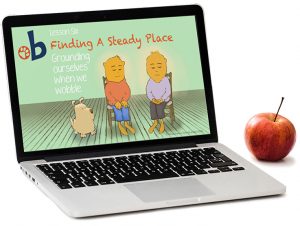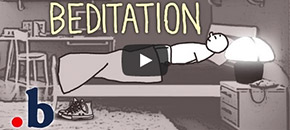#9: Some ideas and support for .b, Paws b and .breathe teachers
We are aware that those who have trained with us to teach MiSP curricula will have a good deal to navigate as they move back into the classroom amidst the current pandemic.
What follows is hopefully helpful guidance on how to:
- Navigate the restrictions in place to reduce the risk of infection
- Be clear about the intentions of certain practices
- Recognise some potential opportunities to be creative in how these are adapted to fit within school guidelines.
 Teaching online – General Guidance
Teaching online – General Guidance
We know that some .b/Paws b/ .breathe teachers have already had a go at teaching these courses online, and while it certainly has a different feel to being in the same room as the students, it is doable. However, back in June 2020 we provided some guidance on how to do this safely and with integrity. Please have a look at the guidance and contact support@mindfulnessinschools.org if you have any questions.
Teaching in the Classroom
The current UK Government Schools Guidance for Full Opening states that, ‘There cannot be a ‘one-size-fits-all’ approach where the system of controls describes every scenario.’
It is therefore important to consult with school in which you are to be teaching regarding existing measures, and make sure you are working within them.
Knowing Your Group or Being with Someone Who Does
In the ‘How to Teach’ booklets and in training to teach MiSP curricula, we strongly emphasise the need to know group you are teaching or making sure you have someone with you who does.
Never has this been more important. To a certain extent, schools themselves won’t have a full sense of the impact that the pandemic and lockdown period has had on the young people returning to their classrooms. The isolation from friends and the daily routine of school and learning will inevitably have had an impact on most students. In addition, we know that those with less stable home environments will have experienced additional difficulty and distress. Some may have witnessed or even experienced the impact of illness associated with the COVID virus, or even lost relatives or family friends to it.
It’s all about intentions
Christina Feldman is often quoted as saying that, ‘everything rests on the tip of intention’. This is something we regularly refer to in training, particularly when we find ourselves getting caught up in the logistical details of where we are doing.
So, while we try to work out how certain aspects of the .b/Paws/.breathe course might sit within social distancing guidelines, it’s a good idea to go back to the intentions of the practice/section of the lesson in question.
For example, in .b Lesson 7, which is all about changing how we relate to strong emotions, we traditionally engage the students in a practice involving slightly raised stress levels. For example, before COVID-19, we might have passed around a toy shock ball, walked around the room with a balloon and the possibility of it being popped, or something similar.
With social distancing in mind, such versions of this exercise would be impossible. This is when we return to the teacher booklet and revisit the intentions of this exercise in order to devise a socially distanced alternative that meets the same intentions. In this case, the intentions are listed as being:
‘….. to gradually increase stress levels (within a safe environment) so that the pupils can pay closer attention – literally ‘attend to’ – what stress is like for them and learn how to manage it.’
How might we do this with distance? It may be that you do something as simple as have a box or bowl containing pieces of paper which have the names of all the students, and mention that you will soon pull out the name of one of the students, and they will then be asked to do a task in front of the group. Would this safely raise stress levels? Will it be an opportunity for them to tune into the stress signs of stress they might be experiencing in their body? Yes. Job done!
The same is the case with the eating practice in .b (Lesson 4) and Paws b (Lesson 4), where we explore: “… noticing the small details of our experience – things we would usually rush past – connecting us with each moment as it happens. When we do this, life feels brighter and fresher.”
How else might we do this in a socially distanced way? Maybe eating something isn’t an option. If it is, is it possible to have sealed packets of something that can be handed out using a sterile spoon? If not, could savouring be done through holding and smelling an object without eating it? If they have their own water bottles, could they use these to drink water with full attention to the details of the experience? There is something wonderful about acknowledging how often we take water for granted, or drink it without fully appreciating we have access to it. This could also be used as an alternative to the ‘grape practice’ in Lesson 8 of .b.
Use of space
How you use space for those sessions where movement or lying down is involved will need some careful planning. Maintaining social distance when engaging the group in mindful movement, walking or lying down will need thinking through in advance.
Once again, let’s return to the intentions of these practices and how these might work in practice:
Mindful Movement/Wobbling and Steadying – to continue to bring awareness to bodily sensation; to explore how it feels to be ‘off-balance’; to explore the body as an anchor point for awareness; to experience just how automatic a lot of our basic movements are; to explore movement while in ‘sensing mode’.
This can be done standing or sitting with no need for students to move from their allotted position /chair in class.
 Beditation – to support students when sleep is difficult due to worry.
Beditation – to support students when sleep is difficult due to worry.
If lying down is not an option, the practice can be done seated, but with an invitation to recline and lean into the back of the chair so there is a feeling of being supported.
Mindful Walking: bringing awareness to sensations of walking – a time when our minds might naturally go elsewhere; another opportunity to see how mindfulness can be brought into everyday activity; noticing what happens when we slow things right down.
Again, this could be done by either standing still and ‘walking on the spot’ or in prescribed lines of direction of as little as 1 metre, turning then walking back one metre, keeping social distance the whole time.
We hope this helps.
We would also love to hear of any other inventive ways in which you have managed to keep the intentions of practices while doing them in a socially distanced way. Please get in touch with any ideas or questions you might have: support@mindfulnessinschools.org
<< Read Top Tip: Teaching Mindfulness Online? Reflections on Safeguarding during School Closures Read Top Tip: Demonstrating the Impact of Mindfulness >>